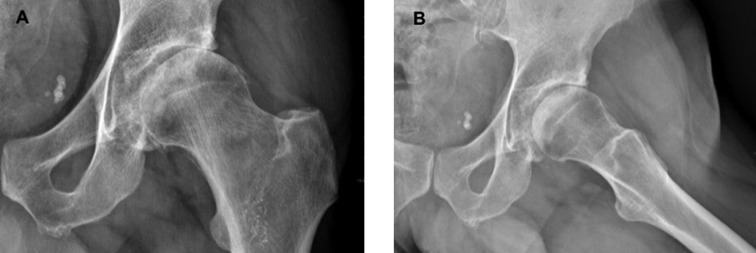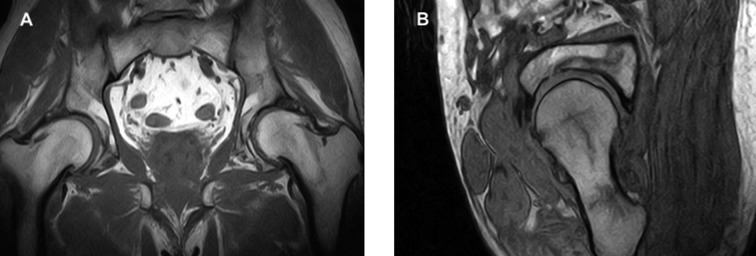Abstract
Background and aim of the work: Osteoarthritis will become even more common in the near future since the average life span is steadily growing. Pain and loss of function are the main complaints reported by patients, inevitably leading towards a worsened daily life performance. New modern techniques have been developed with advanced cell based therapies. Mesenchymal stem cells (MSC) have the inner ability to mature into different types of cells depending on the stimuli they undergo. This technique has already been proven successful in the knee and, with this retrospective study, we would like to assess its feasibility in the hip joint. Methods:6 consecutive patients affected by hip osteoarthritis were treated by intra-articular injection of autologous adipose-derived MSC between June 2017 and June 2018. Our study included only patients with constant hip pain resistant conservative treatment and OA graded 0-2 on the Tonnis grading scale. All 6 patients were evaluated in the preoperative setting and at the 6 months post-operative mark. Results: The HHS showed an improvement from the pre-operative baseline mean value of 67.2±3.4 to the 84.6±6.3 post-operative value. Moreover, the WOMAC score dropped from a baseline score of 36.3±4.7 to 19.8±3.4 at 6 months’ post-op follow up visit. Conclusions: MSC Lipogems is a fairly easy technique. No adverse effects were recorded in our experience. Preliminary results showed a positive outcome according to all the grading systems used in this study even though a longer follow up is needed to validate this technique. (www.actabiomedica.it)
Keywords: hip, OA, MSC, intra-articular injections
Introduction
Osteoarthritis (OA) is one of the main causes of disability in the elderly population and, more precisely the hip is the second most affected joint right after the knee. Nowadays the lifetime risk to develop symptomatic hip OA in people who live to age 85 is assessed at 25% (1-3). Intrinsic risk factors include: age, sex and genetics while extrinsic ones mostly are due to stress. Lower limb joints are subjected to repeated stress factors during daily activities which may cause classic wear and tear damages to joints cartilage. These stress factors include the increasing body mass index, high intensity of certain exercise and heavy manual labor. All the aforementioned risks combine leading to microtraumas and structural damages (2).
Since articular cartilage do not possess a high regeneration rate, due to its avascular nature, it presents a gradual chondrocytes loss, synovial hypertrophy associated with remodelling of the subchondral bone (4-5).
The first step in the treatment process of osteoarthritis is conservative treatment, which entails a course of anti-inflammatory such as NSAIDs and physical therapy to strengthen the muscles surrounding the affected joint and grant better support. In case of failure, intra articular hip joint corticosteroids or hialuronic acid injections are possible, but they have been proved just to slow down the progression.
Operative treatments such as chondroplasty or micro fracturing are ineffective, hip arthroplasty can be premature in early onset cases of OA and it is used as last resort (6).
In the last few years a new technique with Mesenchimal Stem Cells (MSC), harvested from abdominal adipose tissue, has been developed to halt the progression of osteoarthritis.
During the aging process the chondrocytes, that contribute to 5% of the volume of the articular cartilage, decrease their regenerative response, therefore a diminished production of proteoglycans and type II collagen leads to a progressive loss of the articular surface (7). While the adipose tissue has an innate anti-inflammatory quality, the MSCs are multipotent cells and still have the possibility to differentiate into chondrocytes with the adequate stimuli. MSC detect microenvironment changes through multiple growth factors and cytokines present where they reside. In addition up to 2% of cells sited in the adipose tissue are MSC compared to a 0.02% in the bone marrow (7-10). The use of Lipogems has already been proven successful in knee with mild and moderate OA thanks to its feasibility and minimal adipose tissue manipulation, thus maintaining intact the MSC. First and foremost decreased pain was reported in multiple studies associated with improved clinical and functional scores at mid-term follow up. Secondly no treatment-related adverse effects were reported (11-12). In 2017, Mcintyre et al. have published a review of 28 articles for a total of 584 patients and they concluded that intra-articular MSCs therapy is safe, with generally positive clinical outcomes (12). This retrospective study would like to demonstrate the practicality and appropriateness of hip injections with adipose tissue and MSC.
Materials and methods
Between June 2017 and June 2018, 6 consecutive patients affected by hip osteoarthritis were treated with intra-articular injection of autologous adipose-derived mesenchymal stem cells. All the operations were performed by the same surgeon (CDO). Inclusion criteria were: constant hip pain resistant to NSAIDS in the last 6 months or more, functional limitation and/or failure of the conservative treatments. Patients with a recent trauma to the symptomatic hip and with high-grade osteoarthritis (>2 of Tonnis grading system) were excluded from the analysis.
Before the treatment all patients underwent clinical examination with standard X-rays. Moreover, pre- and post-operative Harris Hip score (HHS), WOMAC and Visual Analogue Scale (VAS) pain questionnaires were collected.
Patients were placed in supine position on a standard fracture table with traction applied to the lower limbs. The abdominal wall was chosen as donor site for adipose tissue harvesting. The subcutaneous tissue of the abdominal wall was infiltrated with Klein solution (10 mL of 2% lidocaine and 1 vial of 1 mg/mL adrenaline in 250 mL of saline solution) in order to prepare the harvesting site. Seven to ten minutes at least were awaited before successive adipose tissue aspiration. About 60cc of harvested fat were obtained through a normal lipoaspiration procedure and this material is immediately introduced into the Lipogems® ortho kit (Lipogems International SpA, Milan, Italy) according to the manufacturer’s instructions as described by a recent study (11). By mechanical action the clusters of adipose tissue were reduced in size and the oily substances and the blood residues with inflammatory properties eliminated. At the end of the processing period about 5-10 mL of the final microfragmented adipose tissue product was injected intra-articularly under fluoroscopic control and with traction on the affected limb. All the procedures here described were performed in the same surgical stage.
Figure 1.
Preoperative Antero-Posterior (A) and frog leg (B) Xray of a left hip. This image presents a Grade 1 hip OA according to the Tonnis grading system. The joint space is slightly narrowed and the sphericity of the head maintained
Figure 2.
Pre-operative hip MRI of a 56 years old patient. A) coronal view of the hips. B) Sagittal view of the left hip
The patients were discharged at home on the first post-operative day with indication of non weightbearing for 7-10 days with low molecular weight heparin until the resumption of normal walking. At the same time flexion and extension of the hip were granted immediately, indication to perform at least a post-operative physical therapy cycle, associated with painkillers as needed and local ice (20 minutes, four times a day). Moreover, indication to wear an abdominal compression binder for 20 days. Suture was removed 15 days post-op.
Pre- and 6 months post-operative data about HHS, WOMAC and VAS score were collected. The HHS has a maximum of 100 points, as follows: pain (44 points), function (47 points), range of motion (5 points), and deformity (4 points). HHS total score of <70 is considered poor, 70-80 is fair, 80-90 is good and >90 is excellent.
We have reported data as mean ± standard deviation (SD). Statistical analysis was performed with Student t test. An alpha value of p<0.05 was regarded as statistically significant.
Figure 3.
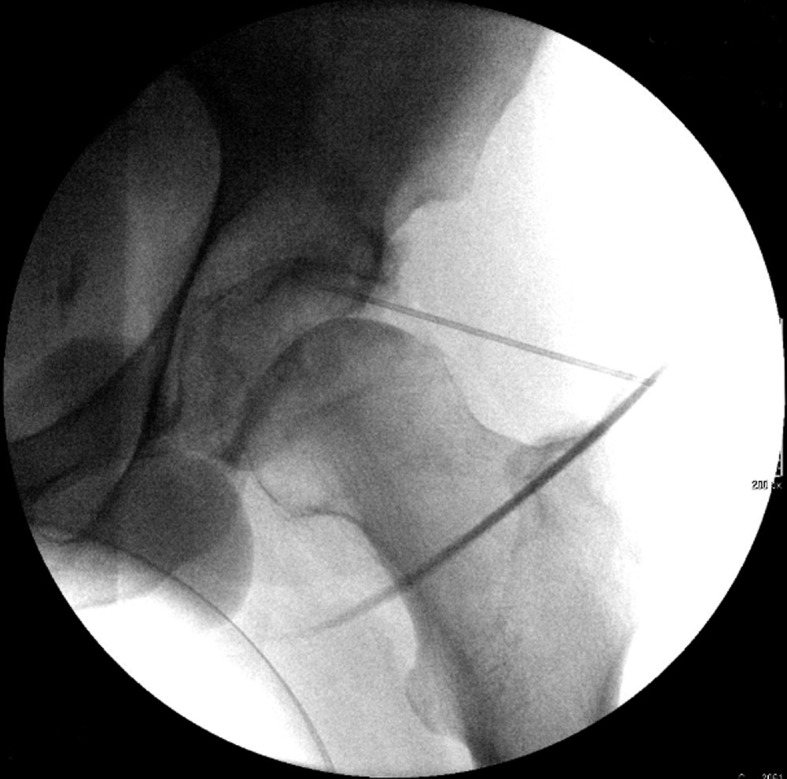
Intraoperative image of a left hip. During the operative time the affected limb is placed under traction to increase the joint space for the injection. Here it is possible to see a needle placed in the hip joint right before the MSC injection
Results
The mean age was 52 years (range, 37 to 60 years). There were 5 male patients and 1 female patient. All of the patients cooperated with the aforementioned postoperative instructions and rehabilitation guidelines.
The mean pre-operative HHS was 67.2±3.4 (<70 poor in five patients and 70-79 fair in one) and the mean 6 months post-operative HHS was 84.6±6.3 (70-79 fair in two patients, 80-89 good in three and >90 excellent in one) (p 0.0001). The mean total WOMAC score was 19.8±3.4 at the 6 months mark after treatment compared to the baseline score of 36.3±4.7 (p 0.0001). The mean pre-operative VAS score was 4.6±0.8 and the mean VAS score 6 months post-operative was 1.5±0.5 (p 0.0001). No patients worsened compared to their respective pre-operative condition. There was improvement of mean VAS score from pre-operative 7.6 to post-operative 3.
No patients had post-operative major complications, only one case reported an organized hematoma on the abdomen after the harvesting of the adipose tissue.
Discussion
Hip OA is a chronic, progressive and debilitating disease. The goal of OA treatment is to reduce pain and increase range of motion in addition to improving quality of life for patients (13).
Figure 4.
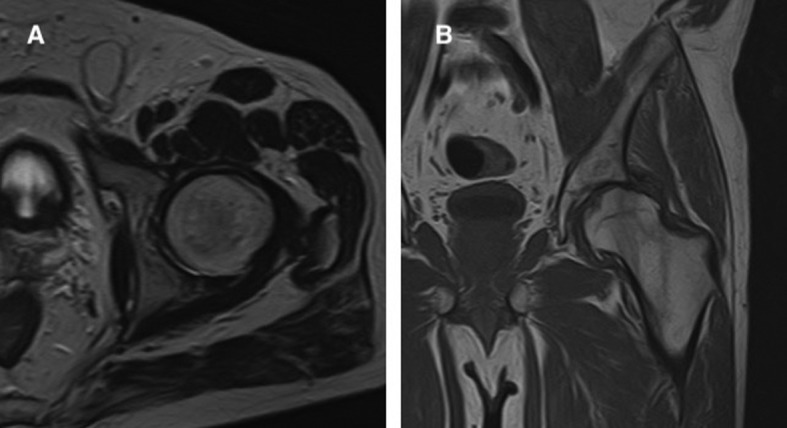
Preoperative MRI of a 61 years old male patient. A) Axial sequence of the left hip. Mild osteoarthritis is noticeable. B) Coronal view of the left hip. Narrowed joint space is visible, associated with sclerosis and multiple osteophytes
Figure 5.
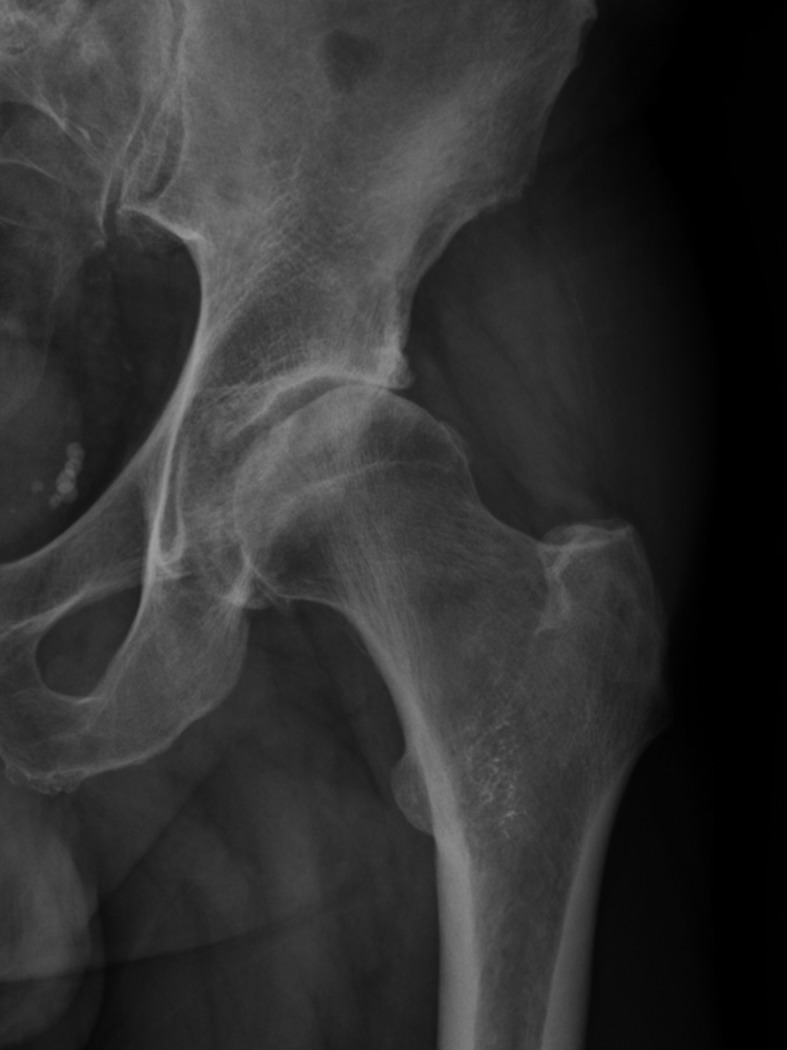
Left hip preoperative Xray of a 61 years old patient. Antero-Posterior view showing narrowing of the joint line. Grade 2 according to the Tonnis grading system.
The main finding of this retrospective study is that injection of autologous and micro-fragmented adipose tissue is a safe treatment for early phases of hip osteoarthritis with good clinical outcome (HHS and VAS scale). It is considered a safe procedure because there were no treatment-related adverse events.
Articular cartilage lesions and degenerations, generally associated with disability and symptoms such as joint pain and reduced function, are hard to treat and remain challenging. Current pharmacologic interventions only temporarily reduce pain and symptoms, but no proven disease-modifying therapy is available (8).
The intra-articular injection of the lipoaspirate grants three main advantages: a natural anti-inflammatory, an early mechanical effect due to its large lubricating capacity and a secondary biological effect due to the ability of MSCs to secrete a variety of bioactive molecules that act in a paracrine way to prime and sustain angiogenic, antifibrotic, antiapoptotic and immunomodulatory responses in target tissue (15). In a joint affected by OA the equilibrium between anabolism and catabolism is weighted in favor of degradation in OA cartilage. The potential for MSCs to restore balance in the affected joint can prevent further destruction (16-17). In our experience, we supposed a possible cross talk between the MSC and the patient’s own pulvinar, in the role of mediation of the inflammation factor and the activation of the mesenchymal stem cells.
The volume of the hip joint cavity is smaller than that of the knee, so less material must be injected (5-10 mL of processed lipoaspirate) to avoid an initial discomfort of the patient.
In 2017, Pak et al. reported a case of percutaneous injections of autologous adipose-derived MSCs mixture in a patient affected by hip OA with significant relief from earlier symptoms. All clinical criteria of FRI, VAS score, and ROM improved on the patient, along with significant MRI changes (18).
In literature, there are numerous studies about treatment of knee OA with an arthroscopic procedure associated with intra-articular injection of autologous and micro-fragmented adipose tissue; in these studies arthroscopic exploration with lavage might be a potential confounding factor. In the present work, we made only the intra-articular injection without any arthroscopic procedure. Therefore, all the improvement in clinical outcome is to be ascribed to the action of the MSCs.
Limitations of the study are: the small number of participants, and no control was included and secondly, while OA has been known as a whole joint disease, the intra-articular injection of adipose-derived MSCs seemed to treat cartilage loss mainly without affecting alignment and other structures.
Conclusions
The hip injection of adipose-derived MSCs increased significantly the clinical scores in patients with early hip OA. The procedure is simple, economic, quick, minimally invasive, single-staged and there were no treatment-related adverse events in regard to the hip procedure. Despite the small number of patients, these preliminary results are positive and promising. The ultimate proof of the clinical utility of this therapy can only come, however, from a prospective, randomized therapeutic trial.
References
- 1.Di Sante L, Villani C, Santilli V, Valeo M, Bologna E, Imparato L, Paoloni M, Iagnocco A. Intra-articular hyaluronic acid vs platelet-rich plasma in the treatment of hip osteoarthritis. Med Ultrason. 2016 Dec 5;18(4):463–468. doi: 10.11152/mu-874. [DOI] [PubMed] [Google Scholar]
- 2.Murphy NJ, Eyles JP, Hunter DJ. Hip Osteoarthritis: Etiopathogenesis and Implications for Management. Adv Ther. 2016 Nov;33(11):1921–1946. doi: 10.1007/s12325-016-0409-3. [DOI] [PMC free article] [PubMed] [Google Scholar]
- 3.Lynch TS, O’Connor M, Minkara AA, Westermann RW, Rosneck JT. Biomarkers for Femoroacetabular Impingement and Hip Osteoarthritis: A Systematic Review and Meta-analysis. Am J Sports Med. 2018 Nov doi: 10.1177/0363546518803360. [DOI] [PubMed] [Google Scholar]
- 4.Hurley ET, Yasui Y, Gianakos AL, Seow D, Shimozono Y, Kerkhoffs GMMJ, Kennedy JG. Limited evidence for adipose-derived stem cell therapy on the treatment of osteoarthritis. Knee Surg Sports Traumatol Arthrosc. 2018 Nov;26(11):3499–3507. doi: 10.1007/s00167-018-4955-x. [DOI] [PubMed] [Google Scholar]
- 5.Jayaram P, Ikpeama U, Rothenberg JB, Malanga GA. Bone Marrow-Derived and Adipose-Derived Mesenchymal Stem Cell Therapy in Primary Knee Osteoarthritis: A Narrative Review. PM R. 2018 Aug 8 doi: 10.1016/j.pmrj.2018.06.019. [DOI] [PubMed] [Google Scholar]
- 6.Dall’Oca C, Trivellin G, D’Orazio L, Sambugaro E, Mezzari S, Zanetti G, Corbo VR, Magnan B. Hip arthroscopy in osteoarthritis consequent to FAI. Acta Biomed. 2016 Apr 15;87(1):46–52. [PubMed] [Google Scholar]
- 7.Damia E, Chicharro D, Lopez S, Cuervo B, Rubio M, Sopena JJ, Vilar JM, Carrillo JM. Adipose-Derived Mesenchymal Stem Cells: Are They a Good Therapeutic Strategy for Osteoarthritis? Int J Mol Sci. 2018 Jun 30;19(7) doi: 10.3390/ijms19071926. [DOI] [PMC free article] [PubMed] [Google Scholar]
- 8.Coughlin RP, Oldweiler A, Mickelson DT, Moorman CT 3rd. Adipose-Derived Stem Cell Transplant Technique for Degenerative Joint Disease. Arthrosc Tech. 2017 Oct 2;6(5):e1761–e1766. doi: 10.1016/j.eats.2017.06.048. [DOI] [PMC free article] [PubMed] [Google Scholar]
- 9.Cattaneo G, De Caro A, Napoli F, Chiapale D, Trada P, Camera A. Micro-fragmented adipose tissue injection associated with arthroscopic procedures in patients with symptomatic knee osteoarthritis. BMC Musculoskelet Disord. 2018 May 30;19(1):176. doi: 10.1186/s12891-018-2105-8. [DOI] [PMC free article] [PubMed] [Google Scholar]
- 10.Dall’Oca C, Cengarle M, Costanzo A, Giannini N, Vacchiano A, Magnan B. Current concepts in treatment of early knee osteoarthritis and osteochondral lesions; the role of biological augmentations. Acta Biomed. 2017 Oct 18;88(4S):5–10. doi: 10.23750/abm.v88i4-S.6788. [DOI] [PMC free article] [PubMed] [Google Scholar]
- 11.Schiavone Panni A, Vasso M, Braile A, Toro G, De Cicco A, Viggiano D, Lepore F. Preliminary results of autologous adipose-derived stem cells in early knee osteoarthritis: identification of a subpopulation with greater response. Int Orthop. 2018 Oct 3 doi: 10.1007/s00264-018-4182-6. [DOI] [PubMed] [Google Scholar]
- 12.McIntyre JA, Jones IA, Han B, Vangsness CT Jr. Intra-articular Mesenchymal Stem Cell Therapy for the Human Joint: A Systematic Review. Am J Sports Med. 2017 Nov doi: 10.1177/0363546517735844. [DOI] [PubMed] [Google Scholar]
- 13.Bianchi F, Maioli M, Leonardi E, Olivi E, Pasquinelli G, Valente S, Mendez AJ, Ricordi C, Raffaini M, Tremolada C, Ventura C. A new nonenzymatic method and device to obtain a fat tissue derivative highly enriched in pericyte-like elements by mild mechanical forces from human lipoaspirates. Cell Transplant. 2013;22(11):2063–77. doi: 10.3727/096368912X657855. [DOI] [PubMed] [Google Scholar]
- 14.Brittberg M, Lindahl A, Nilsson A, Ohlsson C, Isaksson O, Peterson L. Treatment of deep cartilage defects in the knee with autologous chondrocyte transplantation. N Engl J Med. 1994 Oct 6;331(14):889–95. doi: 10.1056/NEJM199410063311401. [DOI] [PubMed] [Google Scholar]
- 15.Caplan AI. Mesenchymal Stem Cells: Time to Change the Name! Stem Cells Transl Med. 2017 Jun;6(6):1445–1451. doi: 10.1002/sctm.17-0051. [DOI] [PMC free article] [PubMed] [Google Scholar]
- 16.Kuroda Y, Kitada M, Wakao S, Dezawa M. Bone marrow mesenchymal cells: how do they contribute to tissue repair and are they really stem cells? Arch Immunol Ther Exp (Warsz) 2011 Oct;59(5):369–78. doi: 10.1007/s00005-011-0139-9. [DOI] [PubMed] [Google Scholar]
- 17.Centeno CJ, Kisiday J, Freeman M, Schultz JR. Partial regeneration of the human hip via autologous bone marrow nucleated cell transfer: A case study. Pain Physician. 2006 Jul;9(3):253–6. [PubMed] [Google Scholar]
- 18.Pak J, Lee JH, Park KS, Jeong BC, Lee SH. Regeneration of Cartilage in Human Knee Osteoarthritis with Autologous Adipose Tissue-Derived Stem Cells and Autologous Extracellular Matrix. Biores Open Access. 2016 Aug 1;5(1):192–200. doi: 10.1089/biores.2016.0024. [DOI] [PMC free article] [PubMed] [Google Scholar]



